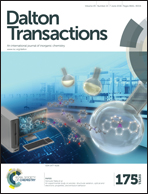Origin of a counterintuitive yellow light-emitting electrochemical cell based on a blue-emitting heteroleptic copper(i) complex†
Abstract
This work provides the synthesis, structural characterization, electrochemical and photophysical features, as well as the application in light-emitting electrochemical cells (LECs) of a novel heteroleptic copper(I) complex – [Cu(impy)(POP)][PF6], where impy is 3-(2-methoxyphenyl)-1-(pyridine-2-yl)imidazo[1,5-a]pyridine and POP is bis{2-(diphenylphosphanyl)phenyl}ether. This compound shows blue photoluminescence (PL, λ = 450 nm) in solution and solid-state and excellent redox stability. Despite these excellent features, the electroluminescence (EL) response is located at ∼550 nm. Although the EL spectrum of LECs is typically red-shifted compared to the PL of the electroluminescent material, a shift of ca. 100 nm represents the largest one reported in LECs. To date, the large shift phenomena have been attributed to (i) a change in the nature of the lowest emitting state due to a concentration effect of the films, (ii) a reversible substitution of the ligands due to the weak coordination to the Cu(I), and (iii) a change in the distribution of the excited states due to polarization effects. After having discarded these along with others like the irreversible degradation of the emitter during device fabrication and/or under operation conditions, driving conditions, active layer composition, and changes in the excited states under different external electrical stimuli, we attribute the origin of this unexpected shift to a lack of a thermally activated delayed fluorescence (TADF) process due to the solely ligand-centered character of the excited states. As such, the lack of a charge transfer character in the excited states leads to a blue-fluorescence and yellow-phosphorescence photo- and electro-responses, respectively. This corroborates recent studies focused on the design of TADF for heteroleptic copper(I) complexes. Overall, this work is a clear insight into the design of new copper(I) complexes towards the preparation of blue LECs, which are still unexplored.


 Please wait while we load your content...
Please wait while we load your content...